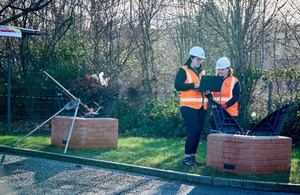Mine water heat lab insights could supercharge clean heat
New data from the UK’s mine water heat lab shows warm water flows better than expected, boosting the case for clean, low-cost heat from coalfields.

Dr Fiona Todd and colleague, Dr Rebecca Chambers, collecting data at the Gateshead Mine Water Heat Living Lab
Six months after launch, the UK’s first mine water heat Living Laboratory is revealing exciting insights into what lies beneath our feet, helping to accelerate the safe and sustainable use of mine water as a clean heat source.
Geophysical data released this month shows, for the first time, how much space there is to store water within the rocks underground and how easily this can flow through historical mine workings.
These 2 factors, known in science as porosity and permeability, are crucial for understanding how much warm water is available, how quickly it can be used and how reliably it can provide heat.
Dr Fiona Todd, geoscientist and lead of the Mining Remediation Authority project, said:
This is the first time we’ve been able to collect this kind of information inside real mine workings.
It’s a huge step forward in understanding mine water heat resources. These properties help us determine how much heat is available, how quickly we can extract it and how sustainable it could be over time.
As part of the new data release, researchers are also sharing remarkable CCTV footage from inside the boreholes, offering the first glimpse into old workings that haven’t been seen since they were last mined decades ago, while also showing water movement and structural features that bring scientific findings to life.
Living lab six-month anniversary
Dr Todd added:
It’s like opening a time capsule, but instead of coal what we’re now extracting is knowledge and possibly clean heat for generations.
These insights were made possible by using specialised tools which were carefully deployed through monitoring boreholes at the Living Laboratory, located between three operational heat schemes in a shared mining block in Gateshead.
Using this equipment, researchers can:
- see how water flows underground
- measure how much heat can be stored and extracted
- understand how mine workings interact across a shared network
Many of the tools used, such as caliper, gamma, density, temperature, electrical conductivity, heat pulse flow meter and CCTV, are commonly used in water wells. However, the team also used a cutting-edge technique called Borehole Magnetic Resonance (BMR), described as “an MRI scan for rocks.” This marks the first known use of BMR in mine water heat research, providing new insight into how water is stored and flows through underground rocks, crucial for understanding the heat resource.
As well as routine temperature and chemistry monitoring results, which have also been released, this new geophysics dataset adds a new layer of understanding to the Living Laboratory’s mission to inform the future of sustainable mine water heat across Britain’s former coalfields.
It provides open-access data to help government, industry and academia work together to broaden the adoption of mine water heat as a viable, long-term renewable resource.
Senior Technical Specialist for the Environment Agency in the North East, Sally Gallagher, said:
As the environmental regulator for England our role is to ensure renewable heat technologies are sustainable and do not adversely impact the environment. It’s great to see the first findings of this innovative research study and understand more how mine water can be used for heating.
Launched by the Mining Remediation Authority in January 2025, the Gateshead mine water heat Living Laboratory is the only facility in the world designed to monitor how heat, water and geology behave between multiple operational mine water heat schemes in a shared underground system.
Further information:
Access the open geophysical dataset for the Living Lab
For media enquiries contact the community response team
Email communityresponse@miningremediation.gov.uk
Telephone 0800 288 4211
For emergency media enquiries (out of hours) call: 0800 288 4242.
Only urgent media calls will be attended to.